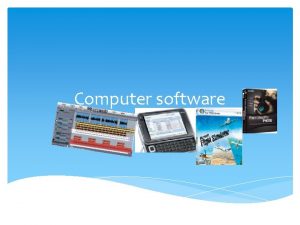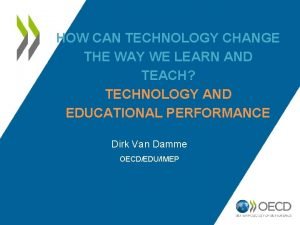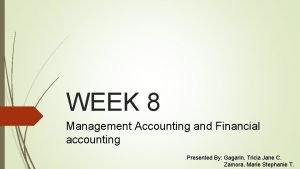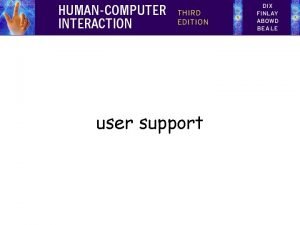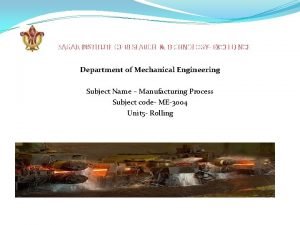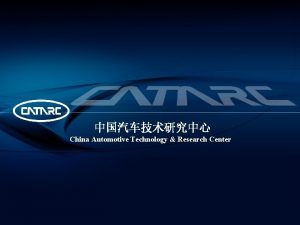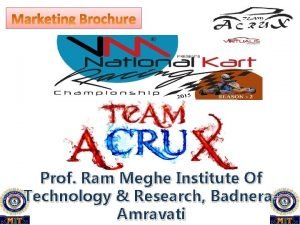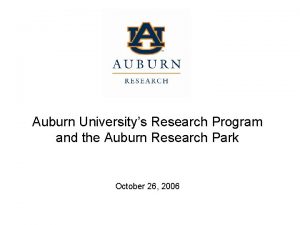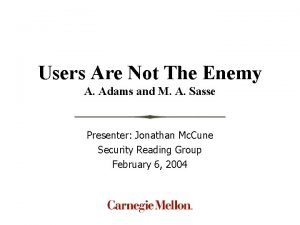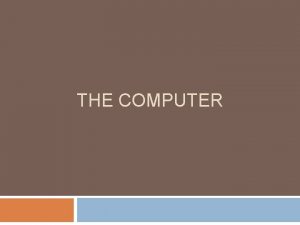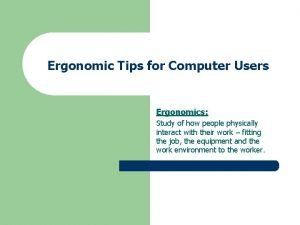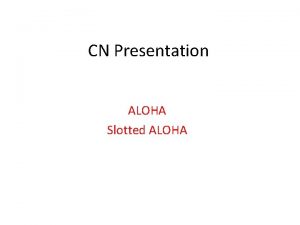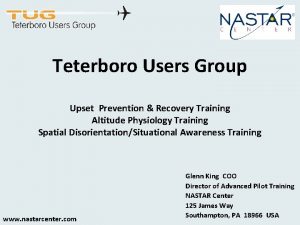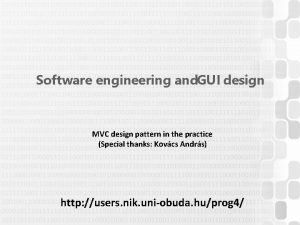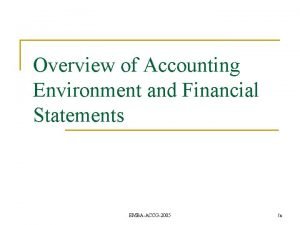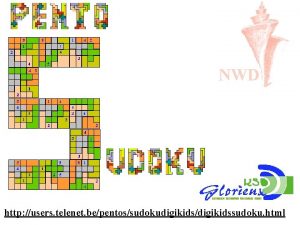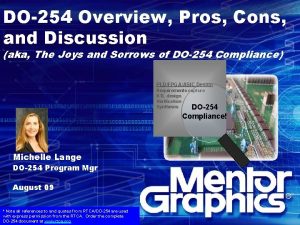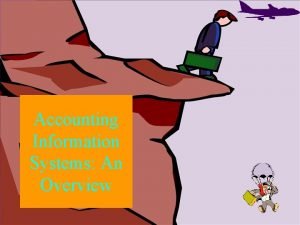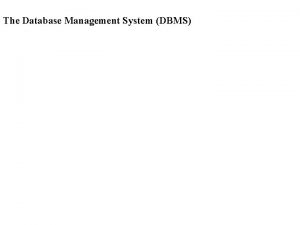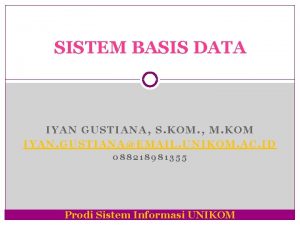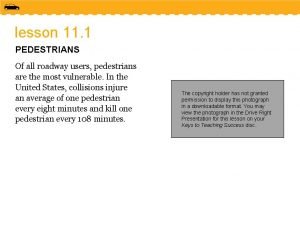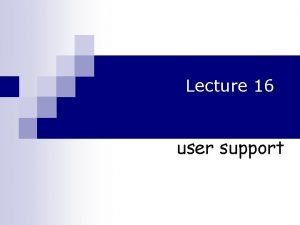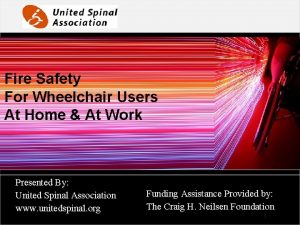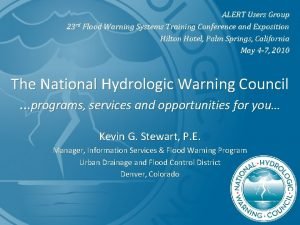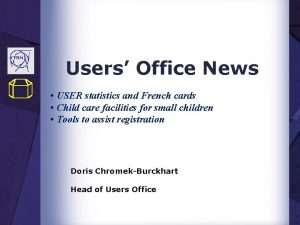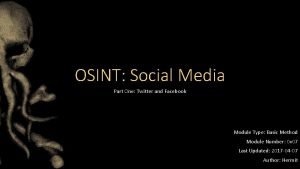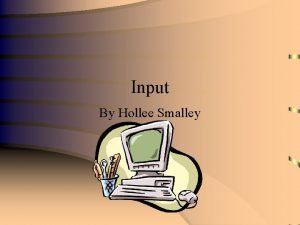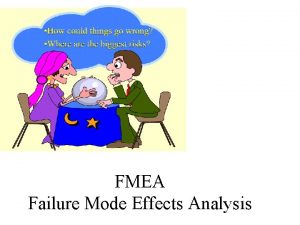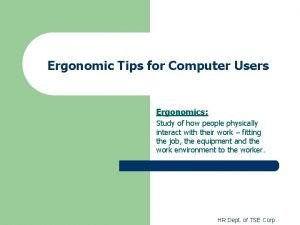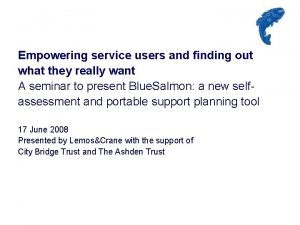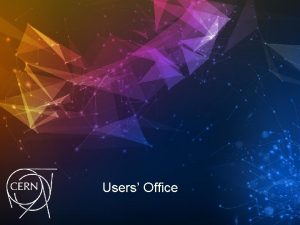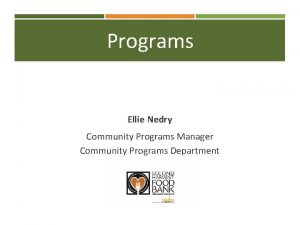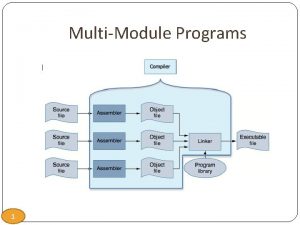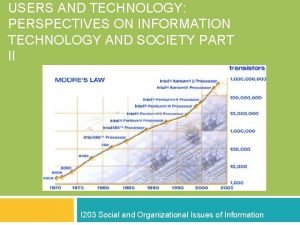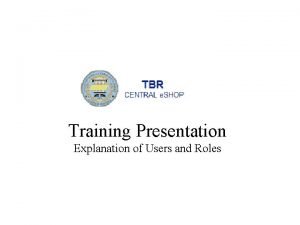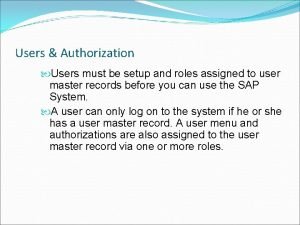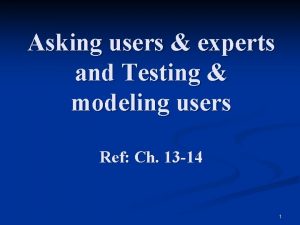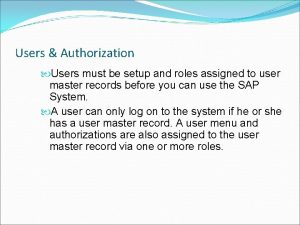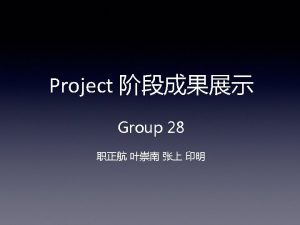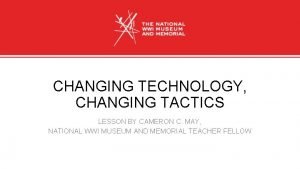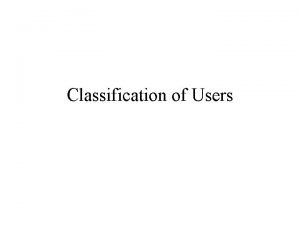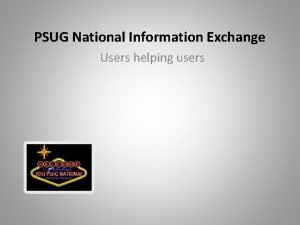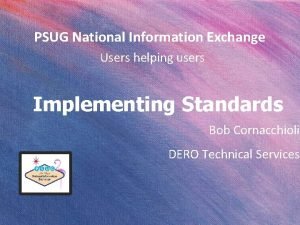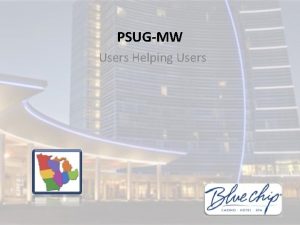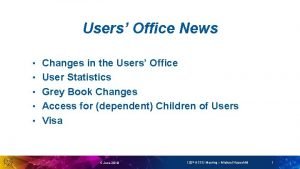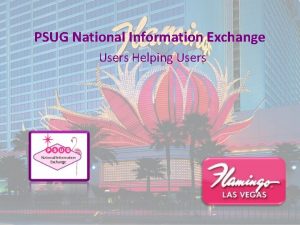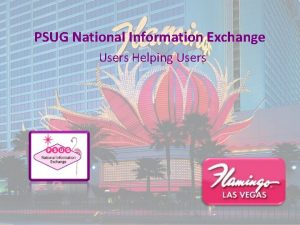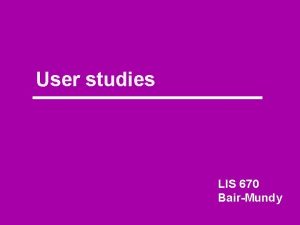Programs and research Changing users and changing technology













































- Slides: 45

Programs and research Changing users and changing technology: the network rewrites the library Lorcan Dempsey CSU Libraries Futures Summit meeting 6 -8 June 2007 Santa Rosa, California

Part 1 Part 2 Part 3

Network user environment institutional operating environment

Part 1: The network user environment


Getting things done Workflow

They found that Google is responsible for referring 56% of the users of High. Wire journals, and our own study shows that over 70% of researchers use it routinely to find scholarly content. Moreover, web search engine referrals also appear to account for the vast majority of accesses to institutional repositories. Van Orsdel L C and Born K Researchers use of academic libraries and their services. Swan A and Brown S

Brand is the new real estate

The rich get richer

~18 months old No Face. Book, My. Space Library?

University of Minnesota http: //www. lib. umn. edu/about/mellon/KM%20 JStor%20 Presentation. pps

Libraries will need to plan for and build services that fit new researcher work habits, with an emphasis on the flexibility and remixing of their content and services. …. … In this study we paid some attention to the new world of informal peer-to-peer communication within the research community. The findings are that researchers are adopting social network technologies very fast and so far they have done so on their own: the library has effectively been bypassed. Researchers use of academic libraries and their services. Swan A and Brown S

Usage of electronic resources Note: the information above appeared in the Perceptions report in both chart and table formats.

Starting an information search Respondents were asked to indicate, from a list of 16 electronic resources, which they typically use to begin an information search. Only 2% of college students start their search at a library Web site. Among total respondents, 84% of information searches begin with a search engine and 1% begin at a library Web site. College Students

Trustworthiness of library sources vs. search engines Over half (53%) of college students indicate a similar trust of search engines as with library resources.

Get in the flow Then: the user built their workflow around the library Now: the library must build its service around the user workflow

Compete for attention Then: resources were scarce and attention was abundant Now: attention is scarce and resources are abundant

Website > workflow Then: people consumed information resources Now: people construct digital identities online: gather, create, share

Chris Beckett http: //www. scholinfo. com/presentations/2006/8/10/the-new-world-order-in-collection-development-the-commercial-perspective. html


Course management: a reductive comparison “The relationship between VLEs and library systems reflects the changes in practice and internal politics wrought by the advent of elearning perhaps more than any of the other systems. There is a sense in which the very identity of libraries and their function in the educational process is at stake. ” [p. 67] Redundant Central • "At one extreme the need for a library becomes superfluous - at its simplest this might be categorized as 'I've got Google, what do I need a library for? '" [p. 67] • Necessary materials are loaded into the VLE, and it points to other resources out on the open web. • The library mediates access to content within the VLE, providing value in selection, purposing to particular tasks, metasearch and so on. Virtual learning environments : using, choosing and developing your VLE by Martin Weller

Susan Hollar - Inside the Course at Michigan Sakaibrary: Michigan Indiana Diane Dallis - Inside the Course at Indiana


Scholarly information flow? Discovery, harvesting Discovery, linking, embedding aggregators Harvesting data analysis, transformation, mining, modeling Research & e-science Deposit, self archiving learning object creation, re-use Deposit, self archiving Learning & teaching Repositories Validation Publish, discovery Data creation, capture and gathering: lab experiments, fieldwork, surveys, grids, media, … Adapted with permission from Liz Lyons e. Bank UK: Building the links between research data, scholarly communication and learning. Ariadne 36, 2003. http: //www. ariadne. ac. uk/issue 36/lyon/ Discovery, linking, embedding peer-reviewed journals, conferences, … A&I services Courses, modules, Learning management systems, learning portals, …

Discovery, harvesting Discovery, linking, embedding aggregators Harvesting data analysis, transformation, mining, modeling Research & e-science Deposit, self archiving learning object creation, re-use Deposit, self archiving Learning & teaching Repositories Validation Publish, discovery Data creation, capture and gathering: lab experiments, fieldwork, surveys, grids, media, … Adapted with permission from Liz Lyons e. Bank UK: Building the links between research data, scholarly communication and learning. Ariadne 36, 2003. http: //www. ariadne. ac. uk/issue 36/lyon/ Discovery, linking, embedding peer-reviewed journals, conferences, … A&I services Courses, modules, Learning management systems, learning portals, …

Discovery, harvesting Discovery, linking, embedding aggregators Harvesting data analysis, transformation, mining, modeling Research & e-science Deposit, self archiving learning object creation, re-use Deposit, self archiving Learning & teaching Repositories Validation Publish, discovery Data creation, capture and gathering: lab experiments, fieldwork, surveys, grids, media, … Adapted with permission from Liz Lyons e. Bank UK: Building the links between research data, scholarly communication and learning. Ariadne 36, 2003. http: //www. ariadne. ac. uk/issue 36/lyon/ Discovery, linking, embedding peer-reviewed journals, conferences, … A&I services Courses, modules, Learning management systems, learning portals, …

Now: Federated access to multi-institutional holdings with support for personal collection-building and sharing

§ Patterns of learning, research, information production and consumption changing § Disclosure into workflows § Personal collections and data reproduction § ‘Customer relation management’

Part 2: The library operational environment

Catalog Metasearch Resolver Print Licensed ILS ERM Knowledgebase Repositories … Digital Research & learning outputs Repositories … …

User environment Switch: delivery, routing, resolution … Management environment

Personal Workflow RSS, toolbars, . . Network level workflow Google, … Institutional Workflow Portals, CMS, IR, … Consumer environments Management environment Bought Licensed Digitized Faculty& students Integrated local user environment? Library web presence Resource sharing, … library … Aggregations Resource sharing

Library “Inventory” 20% head 80% long tail Libraries aggregate supply at the local level… “About the only places you could explore outside the mainstream were the library and the comic book shop. ” Chris Anderson, “The Long Tail”

The long tail Systemwide efficiences Aggregation of supply • Unified discovery • Low transaction costs Aggregation of demand • Mobilize users • Brand Impact?

Libraries and the long tail dynamic Each book its reader Each reader his/her book § Aggregate supply? 1. 7% of circulations are ILLs § (60% of aggregate G 5 collection owned by one library only) § § Aggregate demand? 20% of collection accounted for 90% of use § (2 research libraries over ~4 years) §

Note: All statistics are preliminary and subject to change. Final report forthcoming soon. The Library Long Tail Number of Holdings (using holdings as measure of popularity) “Head” Figure not drawn to scale; for illustration purposes only “Long Tail” Items ranked by system-wide popularity Head: Top 10% of World. Cat records (ranked by holdings) account for 80% of total World. Cat holdings Long Tail: Bottom 90% of World. Cat records (ranked by holdings) account for 20% of total World. Cat holdings

ILL and the Long Tail Note: All statistics are preliminary and subject to change. Final report forthcoming soon. Number of Holdings (FY 2005 OCLC ILL transactions) ~75% of ILL requests were directed at the “Head” ~25% of ILL requests were directed at the “Long Tail” Items ranked by system-wide popularity By comparison, Chris Anderson (The Long Tail, 2006) reports: Amazon: ~ 25% of sales from the “long tail” Netflix: ~ 20% of sales from the “long tail” * Question: are current ILL systems adequately supporting demand for the library long tail?




Holdings: Local, Group, Global Univ Washington collections Summit collections World. Cat

Multilevel approach to … § Collections § § § Shared offsite storage Aggregate and analyse digital collections Institutional repository Digital storage and preservation Social and consumer environments § § § Social networking services: tagging, reviews, recommendations Share mobilizing approaches Virtual reference § D 2 D § § Consolidated discovery Knowledge base Resolution - Service routing – fulfilment Business intelligence § § § Synthesize and mobilize shared usage data Recommendation, management decisions Digitization and offsite storage

Part 3: conclusion

§ Libraries optimized for a pre-network environment § User environment: libraries do not have webscale: impact suffers § Operational environment: fragmentation and redundancy § Resources organized around value creation? § Find the appropriate level to act ….

Reduce unnecessary fragmentation and redundancies Increase the impact of libraries Put libraries at the point of need Make the network for libraries Build the library brand on the network Create systemwide efficiencies
 Use of software
Use of software Cpmcd full form
Cpmcd full form How is technology changing the way we learn
How is technology changing the way we learn Internal users of accounting information
Internal users of accounting information It monitor users behavior and offer contextual advice
It monitor users behavior and offer contextual advice Accounting language of business
Accounting language of business Internal users of accounting information
Internal users of accounting information It focuses on short updates of the user
It focuses on short updates of the user Boeing research and technology
Boeing research and technology Sagar institute of research and technology
Sagar institute of research and technology China automotive technology & research center
China automotive technology & research center Prof ram meghe institute of technology and research
Prof ram meghe institute of technology and research Boeing research and technology
Boeing research and technology Auburn research park
Auburn research park Web accessibility for older users
Web accessibility for older users Users are not the enemy
Users are not the enemy Allows rapid entry of text by experienced users
Allows rapid entry of text by experienced users Limitations of financial statement analysis
Limitations of financial statement analysis 5 examples of people as media
5 examples of people as media Ergonomics tips for computer users
Ergonomics tips for computer users Pure aloha vs slotted aloha
Pure aloha vs slotted aloha System of accounting
System of accounting Nnnn enemy
Nnnn enemy Teterboro users group
Teterboro users group Users.nik.uni-obuda/kovacs.andras
Users.nik.uni-obuda/kovacs.andras Users of accounting information
Users of accounting information Is fax machine an output device
Is fax machine an output device Sudoku telenet
Sudoku telenet Do-254 training
Do-254 training 5 users of accounting information
5 users of accounting information 5 users of accounting information
5 users of accounting information Cern prt
Cern prt Allianz cern mpa
Allianz cern mpa Naive users in dbms
Naive users in dbms Casual end users
Casual end users Are the most vulnerable roadway users
Are the most vulnerable roadway users Users over lack support
Users over lack support Wheelchair fire escape
Wheelchair fire escape Alert users group
Alert users group Users office cern
Users office cern Https://twitter.com/search?f=users&q=dave%20melin
Https://twitter.com/search?f=users&q=dave%20melin Using marketing information to gain customer insights
Using marketing information to gain customer insights Input devices for physically challenged users
Input devices for physically challenged users Users of an fmea should consider a scale of 1-5 for sod’s
Users of an fmea should consider a scale of 1-5 for sod’s Ergonomics tips for computer users
Ergonomics tips for computer users Empowering service users
Empowering service users
